Both with regards to technology and financials, AMD 0.00%↑ has been on a tear for the last several quarters, and their new Q3 numbers has seen that company continue that trend – with no immediate signs of it stopping. Not only are the Q3 numbers the biggest, but it means the datacenter business is now more than half the company, and Q4 numbers are expected to shatter the ceiling once again.
AMD has been the beneficiary of significant growth of demand for its data center and AI products for over a year now, and Q3’24 has been a particularly productive quarter in that regard, thanks to the continued adoption of AMD’s MI300X series of AI accelerators, along with the ramping of the company’s Zen 5 CPU architecture and associated EPYC 9005 “Turin” processors. In fact, AMD has now crossed the 50% threshold for data center/AI revenue – now more than half of the company’s revenue comes from that explosive business unit. All the while, AMD has increased their 2024 revenue estimate from the MI300 series yet again; last quarter’s $4.5b estimate has been thrown out the window, and now AMD expects to clear $5b for the year. This is on the back of strong client gains as well with a couple of launches in the quarter, offsetting the loss in the gaming market. The slow decline of the embedded segment is now reversing, as was guided earlier in the year.
Overall, AMD has continued to showcase a strong growth trajectory. We'll go through the numbers and the trends in each business unit.
Key Takeaways
💵 Overall Revenue, $6.819b, up 18% YoY from $5.800b and up 17% QoQ
GAAP:
📈 Gross Margin at 50%, up 3pp YoY and up 1pp QoQ
💰 Op Income at $724m, up from $224m YoY and up from $269m QoQ
🪙 EPS $0.47, up 161% YoY, up 194% QoQ
Non-GAAP
📈 Gross Margin (non-GAAP) at 54%, up 3pp YoY and up 1pp QoQ
💰 Op Income at $1.715b, up 34% YoY and up 36% QoQ
🪙 EPS $0.92, up 31% YoY and up 33% QoQ
Outlook is as follows:
💵 Q3 Revenue, $7.500b, +/- $300m
📈 Q3 Gross Margins (non-GAAP) of 54%.
Analysis
AMD’s strong growth over the last several quarters has allowed the company to repeatedly beat market expectations and their own revenue guidance, and this latest quarter was no exception. AMD’s top-line expectation for revenue for Q3’2024 was $6.8b, and at $6.819b on the books, AMD has pushed past even that. Meanwhile a look at Wall Street expectations has AMD beating those on a revenue basis as well, though only hitting the mark on an earnings per share basis. This is once again AMD’s biggest quarter ever in terms of revenue, handily beating out Q2’2022’s impressive numbers at the height of the pandemic demand – never mind AMD’s historic performance.
Looking forward, AMD is expecting their revenues to continue their significant growth going into Q4, built on the back of ever-larger sales of AI accelerators, along with AMD’s new portfolio of Zen 5-powered processors showcasing a wide and varied portfolio. For Q4, the company is projecting $7.5b +/- $300m in revenue, which on a percentage basis, is a narrower window of variability than Q4’2023, but again would be another record quarter. This is being driven primarily by achieving milestones with customers deploying MI300X ahead of schedule, leading to further build-outs or replacement of old infrastructure. AMD expects to clear $5b in revenue alone from their MI300 family of accelerators, emphasizing how much of that overall growth is underpinned by their AI accelerators.
Still, AMD 0.00%↑ ’s stock price is currently down just over 7% in after-hours trading, reinforcing the lofty expectations that investors have for the AI-fueled company, and how much of those expectations are already baked into AMD’s stock price. Even coming out a bit ahead of their own aggressive revenue expectations is a disappointment to investors who have become accustomed to the torrid pace of growth in this segment.
This is where we stand with each business unit.
Overview
Datacenter - EPYC, Instinct
➡️ Revenue $3.549b, up 122% YoY from $1.598b
➡️ Operating Income $1.041b, up from $0.306b YoY
➡️ Operating Margin 29% , up from 19% YoY
The star segment of AMD’s current product portfolio, AMD’s data center segment has been driving the bulk of the company’s growth over the past year, and with it, their meteoric rise in profitability thanks to the high margins on these parts. At $3.549b in revenue, this is yet again a record quarter for AMD’s business segment. And with 122% year over year growth in revenue, the company isn’t just slightly edging out their previous records. Based on the analyst Q&A underneath, this is around $1.7 billion CPU and $1.5 billion GPU.
In fact, AMD is now a de-facto data center/AI company, with 52% of their revenue coming from this profitable segment (a mark they just missed last quarter). And while this segment is not AMD’s only growing segment, the company is well positioned for the data center segment to become an even larger piece of the pie in future quarters. In the Q&A, Lisa pointed to increased engagement with all the major providers in cloud, but also an uptick in enterprise even with the longer sales cycle of that market.
That will continue into Q4, when AMD launches their 2024 refresh part, MI325X, which will offer memory and memory bandwidth improvements for memory-hungry LLMs. All the while, customers are still snapping up MI300X accelerators at a rapid pace, with AMD touting significant orders from Microsoft and Meta. As part of the prepared remarks, it should be noted that AMD stated that Meta has already deployed 1.5 million EPYC CPUs into its infrastructure, with perhaps more to follow. We already know at this point $MSFT is more than 50% AMD internally, and uses AMD on its ChatGPT inference due to the TCO advantage. Meta is using MI300X exclusively for its Llama 3.1 405B foundation models.
Looking forward, as revenue is still MI300X focused, the MI325X part will increase through the first half of 2025 as production ramps up. AMD stated that margin for those parts is below corporate average, but the increased engagement and ramp will help drive operational efficiencies such that, long term, it is above that vital metric. Turin will start in revenue soon as well, and for GPU, MI350 is on track to launch in the second half of 2025, while MI400 is still slated for a 2026 launch.
Client - Ryzen, Ryzen Mobile/AI
➡️Revenue $1.881b, up 29% YoY from $1.453b, significant gain QoQ vs $1.492b
➡️Operating Income is $276m, up from $140m YoY
➡️Operating Margin is 15%, up from 10% YoY
Client hardware has been the other strong performer for AMD’s Q3 earnings. As with their data center CPU sales, the company is enjoying the fruits of launching their new Zen 5 CPU architecture in the last few months - in the client segment, this translates into their Ryzen 9000 series desktop CPUs and Ryzen AI 300 mobile CPUs.
The 29% year over year (and 26% QoQ) growth is a welcome change for this segment, which has struggled off and on in previous quarters. The 15% operating margin still won’t look very impressive to the corporate averages, but this is 5 points higher than the year-ago quarter.
Q4 will continue to see AMD’s new Ryzen parts ramp in volume, and the overall product stacks expand. Of particular note here will be the Ryzen 9000 X3D chips with AMD’s novel stacked V-cache technology, which will launch on November 7th. These have historically played well with the higher margin gaming market.
Meanwhile the company is also reporting that they’re ramping up laptop shipments, with Acer, HP, Lenovo and Asus all preparing further Ryzen AI 300-based laptops, as well as devices based around AMD’s new enterprise-focused SKUs, the Ryzen AI PRO 300 family. Though it may be another couple of quarters until AMD can really capitalize on this momentum and provide ample mobile chip volumes.
Gaming - Radeon, Consoles
➡️Revenue $462m, down 69% YoY from $1.506b
➡️Operating Income is $12m, down from $208m YoY
➡️Operating Margin down 12pts to 2%
While AMD’s data center and client offerings are the bright points for this quarter, AMD’s gaming offerings find themselves in a major rut. The amalgamation of AMD’s client GPU sales and their semi-custom console APU sales, AMD’s gaming revenue is at its lowest point in at least 3 years, with the company booking just $426m in revenue, down 69% YoY. And even on a more charitable quarterly basis, this is a 29% drop.
The poor performance here is a combination of a few factors, not the least of which is simply timing. At two years old, AMD’s Radeon RX 7000 family of video cards is approaching the tail end of its retail sales window, as attention turns to AMD’s forthcoming, RDNA4 architecture-powered cards. Meanwhile, AMD’s semi-custom customers have been drawing down their own inventory (despite the recent Playstation 5 Pro launch), ordering far fewer chips from AMD as a result. Officially, AMD is attributing the latter as the primary reason for the gaming revenue drop. With an operating margin of 2%, AMD is essentially losing money on their gaming hardware for the moment.
Looking forward, AMD reports that they will be launching their first RNDA 4 GPUs in early 2025. Meanwhile, there is no specific guidance on when semi-custom sales may improve, which historically is what’s driven much of AMD’s gaming revenue.
Embedded - Xilinx, AMD Embedded
➡️Revenue $927m, up from $861 QoQ
➡️But down from $1.243b YoY, down 25%
➡️Op Income $372m, down from $612m YoY
➡️Op Margin 40%, down from 49% YoY
AMD’s embedded segment has been dealing with post-pandemic inventory drawdowns for a while now, and that has continued in to Q3. For the quarter, AMD booked $927m in revenue, which is down 25% on a YoY basis, but up sequentially.
At one point, AMD expected the bust in this market to break in Q1, which didn’t pan out. But things are finally, if slowly, turning around. On a quarterly basis, embedded revenue is up by $66m, growing 8% over Q2’2024. This marks the second consecutive quarter of revenue growth for this segment, though a far cry from its highs over the previous two years. Customers seem to be going through the digestive phase - Lisa said that the strength here is mostly in the test/emulation markets, also in aerospace and defence, however communications and embedded is still soft.
AMD’s guidance here is essentially that the expect the slow recovery of this market to continue, with AMD intending to position themselves to beat the market on growth on a long-term basis. Of note, the company is expecting to see design wins grow by 20% year over year, which they are hoping to fuel that revenue growth. Coupled with that, as always, has been several new products launched in the last quarter, including EPYC Embedded 8004 processors as well as new UltraScale+ chips for the automotive market. And looking a bit farther down the line, AMD will have their second-generation of Versal adaptive SoCs, codenamed “Telluride”, which was taped out in Q3. Over 2025, AMD expects some modest growth in its business.
Outlook
💵 Q3 Revenue, $7.5b, +/- $300m
📈 Q3 Gross Margins (non-GAAP) of 54%
Conclusions
AMD has achieved something Intel found impossible to do - make half of its company focused on the higher margin datacenter markets. We honestly knew this was coming for a while, the question was supposed to be when - AMD gave us a $2b revenue number for AI at the start of the year, and now that’s more than doubled to $5b+ as they’ve been able to deploy at customers ahead of schedule and meeting the requirements for those businesses to choose AMD over the competition. Deployments still list software as a weak point for AMD, hence the recent acquisitions of nod.ai, mipsology, and silo.ai, and there is a general consensus that ‘it’s getting better’, but it still has to march on rather than simply relying on individual large customers to simple ‘get their stuff working’.
The acquisition of ZT Systems has now passed regulatory hurdles, so AMD is expecting that to complete in the first quarter of 2025. With ZT, AMD should be able to drive more efficient deployments into cloud and enterprise, with a recognized set of people that should know what they’re doing. Whether AMD will derive a service revenue from that business is unclear at this point, however it would all get funnelled into the DC side.
As for the outlook, $7.5b for Q4 is going to be another record breaking quarter for AMD. Right now AMD says $5b+ for AI for the year, and given some of the numbers thrown out by analysts such as Stacy Rasgon, it’s expecting to be mid-to-high $5b in order to make it all work. But nonetheless, there’s going to be lots of AMD GPUs out there in Q4 and next year. This ties in with TSMC expanding its packaging facilities, and if what Harlun Sur (again, below) is correct, AMD might snatch 10-15% of the AI market next year. Something to think about.
More Than Moore, as with other research and analyst firms, provides or has provided paid research, analysis, advising, or consulting to many high-tech companies in the industry, which may include advertising on the More Than Moore newsletter or TechTechPotato YouTube channel and related social media. The companies that fall under this banner include AMD, Applied Materials, Armari, ASM, Ayar Labs, Baidu, Dialectica, Facebook, GLG, Guidepoint, IBM, Impala, Infineon, Intel, Kuehne+Nagel, Lattice Semi, Linode, MediaTek, NordPass, NVIDIA, ProteanTecs, Qualcomm, SiFive, SIG, SiTime, Supermicro, Synopsys, Tenstorrent, Third Bridge, TSMC, Untether AI, Ventana Micro.
Analyst Q&A
This segment has been partially cleaned for clarity. Answering the calls was CEO Lisa Su, and CFO Jean Hsu.
Q: Toshiya Hari, Goldman Sachs: On Datacenter GPU, you positioned the 2024 outlook up to $5b. What drove the change? In 2025, how are you thinking about Instinct growth in the cloud vs enterprise - are you adding new cloud customers on Instinct?
A: Strong Q3 in datacenter overall, and especially in Instinct. We completed important milestones with customers, so our revenue is above initial Q3 expectations. We raised overall guidance for the full year based on the completion of some of those milestones. In 2025, we feel good about the market, about all we see from talking to customers, and there's still significant investment in workloads. Our portfolio is getting stronger with our annual cadence - we have MI325X launched, and MI355X coming in 2H25. Customer engagements are broadening quite well - cloud customers are moving and optimizing workloads to the EPYC servers they're running. We're engaged with large cloud and enterprise optimizing for EPYC, that's good for us.
Q: On gross margins, you're guiding flat in Q4. What are the puts and takes? In 2025, you said you expect to continue datacenter growth - and for embedded to recover. You expect server CPU enterprise would grow faster? Are those points valid? Headwinds?
A: We are pleased with Q3 gross margin performance, 53.6%. Guiding 54% in Q4. In 2024, our GM improvement is grown by the mix - in the datacenter especially, with more than 50% of the mix for GM. In 2025, our largest growth is datacenter business. For CPU, GPU, we see our enterprise business growing by tailwind on gross margins. Client business expands nicely, client is more focused on consumer, which is below corporate average. The team has done a great job on operational efficiency. Scale in 2025, benefit from that scale to improve GM.
Q: Aaron Rakers, Wells Fargo - Supply of MI325X into 2025?
A: Happy with our supply ramp in the last few quarters. It's a tight supply environment, but we ensured we had capacity across our entire chain. Part of the reason for higher revenue in 3Q in Instinct - customer demand and supply chain improvement. In 2025, we expect tightness, but we've planned for growth. We feel good.
Q: Sequential guidance uplift: Client vs Datacenter?
A: Largest is the datacenter. That's now 50%+ of our business in Q3 and it will continue to grow in Q4. Our client business will do well - we've done well on desktop and notebook AI PC, and we expect growth there. Other segments will be modest.
Q: Ross Seymour, Deutsche Bank - Segment guidance, you didn't mention embedded is up? It’s a muted recovery, but what's happening in Q4 guidance and 2025 generally?
A: We’ve seen some improvement in embedded. There’s a modest improvement in Q4 - it's a mix across sub-segments. Some are stronger, like test/emulation, and we are ramping a new Versal platform there. Aerospace and defence are also doing well. Comms has not seen much recovery, and industrial is on the soft side. Across all, we see a little growth in Q4, and modest growth in 2025. We’re planning it'll be mixed.
Q: Datacenter - is Instinct taking away from EPYC, CPU vs GPU, from customer spend?
A: On the datacenter CPU, we’ve been impressed by the progress. The market is getting better over quarters, and larger cloud customers are adding to their datacenter capacity as well as in the refreshes. In enterprise, there are modernization opportunities. Our portfolio has done well - in Q4, Zen 4 Genoa and Bergamo were strong. The ramp of Zen 5 Turin will also happen. We saw demand even on Zen 3 Milan this quarter given the performance and price ratios there. We have a strong stack, and we see strength in the datacenter market, also AI.
Q: Ben Reitzes, Melius Research - You have share gains in 2025, but we see GPUs are cannibalising CPU spend. What is Turin with this momentum - the right CPU for a GPU, are hyperscalers liking consolidation for AI room - what's the catalyst?
A: When I look at Turin and 2025, Turin is well optimised for a broad set of server workloads, traditional CPU workloads, with both scale up and scale out. There will be strong AI content on the CPU, and that helps Turin as well. It's an important head node in GPU configurations. It's all good catalysts for us. We're expanding workloads in general with large cloud customers, with strong progress in enterprise. Enterprise sales takes longer, proof-of-concept work, making sure CIOs are familiar. Between our Zen 4 and Zen 5 offerings, we have a board portfolio for traditional CPU.
Q: There are general concerns of consumer weakness in the market. Is a more than seasonal decline possible in Q1 in PC?
A: A few things. Our business is more consumer weighted - so having the second half of the year perform better than the first half is usual for us. Also this year, we had the Ryzen 9000 launch, and also our AI PC Ryzen AI 300 products. The combination has given us a stronger than normal 2H. There will be seasonality in 1H, that's typical. This is the strongest PC portfolio we've had in our history across desktop and notebook. In 2025, we have optimism in PCs, with the market growing mid single-digits. The AI PC catalyst, as well as Win10 end of support in 2025, will help.
Q: Joshua Buchalter, TD Cowen - On datacenter GPU, everyone wants new customers and guidance for 2025. Can you speak to the runway at existing customers, and if MI325X/MI355X are growing workload breadth at existing customers?
A: We're very pleased with the datacenter GPU business. When we started the year, we launched MI300, we talked about $2b revenue in 2024. As we've gone through, we've completed customer milestones, things like at scale in the Datacenter meeting the reliability requirements as well as optimising on workloads and performance out of the box. We have gained confidence in the last 2-3Q seeing customers ramp - everyone wants faster, but we think it's going well. So we’re talking $5b+ in 2024, and we feel good. We feel great about 2025, there's significant capex investment and our portfolio, and it's getting stronger. Software side, our customer support/engagement, out-of-box, open source ecosystem. Our customers can work at scale, with great TCO. Great opportunity to grow at current customers, eg We had $Meta at our event (Advancing AI in October) talking inference with Llama 3.1. $MSFT has been a great partner too. We're working with all large customers, and we have many deep engagements with us on optimizations.
Q: Timothy Arcuri, UBS - $1.5b of Instinct in Q3, $2b in Q4?
A: We did better than expectations in Q3. We're now seeing our GPU scale approach our CPU scale.
Q: For 2025. You seed big customers - can you grow off that Q4 level? MI355X can drop into existing infrastructure. What about the demand for rack-scale, would there be a pause to 2026?
A: This business, there's a lot of activity with customers building datacenters. Some want air cooling, some want water cooling, some want rack-scale, some want integration into existing sites. In 2025, we feel good about growth opportunities. It might be lumpy, these are large customer acquisitions, and they’re not always predictable which quarter for buildout, but we feel very good in 2025.
Q: Joe Moore, Morgan Stanley - $5b in AI revenue for 2025 - what’s the breakdown in training vs inference?
A: Primarily inference given memory capacity and bandwidth upsides. We do have training adoption, and we expect that to grow. In 2025, we expect a balanced portfolio.
Q: Vivek Arya, BoA - How do you address investors that MI300 is a good start but a year behind the competition technically?
A: We don't see that. When we launched MI300, it was behind H100, but with our roadmap we've closed that gap. MI325X is competing well with H200, and MI355X with Blackwell. The market is still constrained, with new product generations coming, and it takes time from shipping samples to ramping volume production workloads. One advantage we have with our portfolio is that our hardware is easier to integrate into existing infrastructure. Our roadmap is strengthening over time, and customers agree.
Q: On Client, the business unit is up 26% sequentially with growth in Q4. How do you see the state of the channel, if sell-through in Q3 looks flat. Is that ASP or units? As you look to 2025, is that ASP strength, or the mix that benefits you?
A: Our client business has a few factors different to the overall market. Our desktop share is high in the channel, and we saw strength in that portfolio in Q3 with strong sell-through. On the notebook segment, it's more consumer rated, so 2H of year is the focus. There is good momentum on AI PC, and our activation rates of AI 300 are good, but it's very early in that cycle. We'll see units up, ASPs will vary based on consumer vs commercial. It's an opportunity for us, we're underrepresented in consumer and enterprise.
Q: Harlan Sur, JP Morgan - Follow through QoQ growth for enterprise?
A: We did see positive growth in 3Q in enterprise - broader adoption in on-prem and cloud 3rd party deployments. People can migrate either way, or from old to AMD. That helps us in enterprise and cloud. Into 4Q, we are expecting more growth sequential for server, enterprise and cloud. The enterprise business, we are underrepresented, but platforms have strengthened with OEMs. Zen 4 and Zen 5 - opportunities for 2025.
Q: Also, China?
A: In China, we are underrepresented in CPU. We can gain share.
Q: Stacy Rasgon, Bernstein - The size of datacenter GPU revenue, you said it was approaching CPU. I have that around $1.7b. Is that right? So if we model for $5b for the year for GPU, you would be down in Q4 at $5b. You would need $5.2 to be flat. Is that right?
A: In our datacenter, we have other revenue not just CPU and GPU, we have FPGAs too. I said it was greater than $1.5b for GPU. We didn't guide an exact number for the full year, just exceeding $5b.
Q: You mentioned datacenter GPU lumpiness in 2025 - is that seasonality, specifically into Q1?
A: Nothing implied from the previous comments - it’s more so the evolution of that business depends on specific large customers driving deployments. Eg Q3 we saw extra demand. Will have to see how things evolve.
Q: Harsh Kumar, Piper Sandler - The stock 10 years ago was $3, so congrats on 10 years! In 2025, your key competitor will take most of the TAM in the GPU market, something like $50-60b, and you'll get $5-10b for example. What is the major hindrance? Are you just early in your AI cycle?
A: We view it as opportunities. If you take our EPYC ramp from Zen 1/2/3/4, we had a good product even with Zen 1, but it takes time to ensure trust, familiarity. There are some differences, hardware, software, so with ramp we're positive on ramp rate. It's our fastest product ramp. It's a multi-gen journey, we've always said that. Next year is expanding the customer set and workloads. Into MI400, it's an exceptional product. Ramp is going well. We will continue to earn trust and partnerships with large customers. Customers are very open to AMD - we see that everywhere. Everyone is giving us a fair shot at earning their business.
Q: Gross margins for MI300/MI325X is below corporate average. What’s the framework for how they get to parity with the rest of the business?
A: Very pleased with the revenue ramp of the datacenter GPU. Our team supports the ramp and improves GM, and yes it's below corporate average, and into 2025, our top priority is to match customer demand and increase market presence for revenue growth. For margin, as we ramp revenue, we expect to improve margin. In Datacenter, in the longer run, it tends to be better than corporate average. It might take time to get there - but for our datacenter performance in 2024, we doubled revenue year on year, but tripled (!) operational income YoY. We are driving long term growth of market presence and drive margins.
Q: Thomas O'Malley, Barclays - On the mix of MI300 into Q4 with MI325X. Is the new product significant, or is its impact in Q1?
A: Q4 mix would expect majority MI300, with ramp of MI325X at end of the quarter into Q1.
Q: If you look into next year, what are the end markets for embedded into Q4 and Q1?
A: Trends are similar for the Q3/Q4 timing. We do expect some of the markets will recover, gradually. The strength is in test/emulation segments, we see strength in aero/defence, and a little in automotive. We're waiting on comms/industrial. We'll get more visibility as we go through to the end of year.





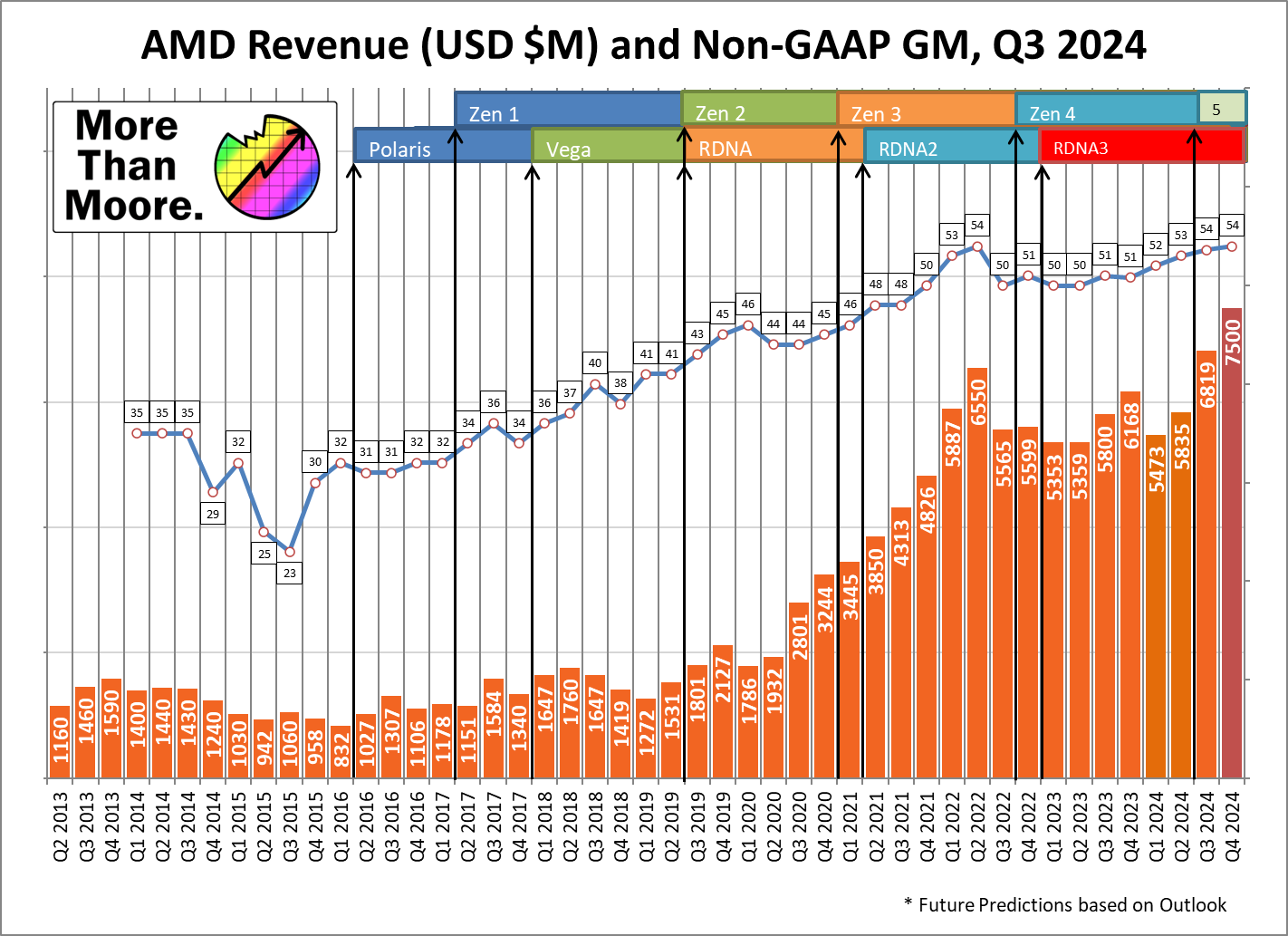
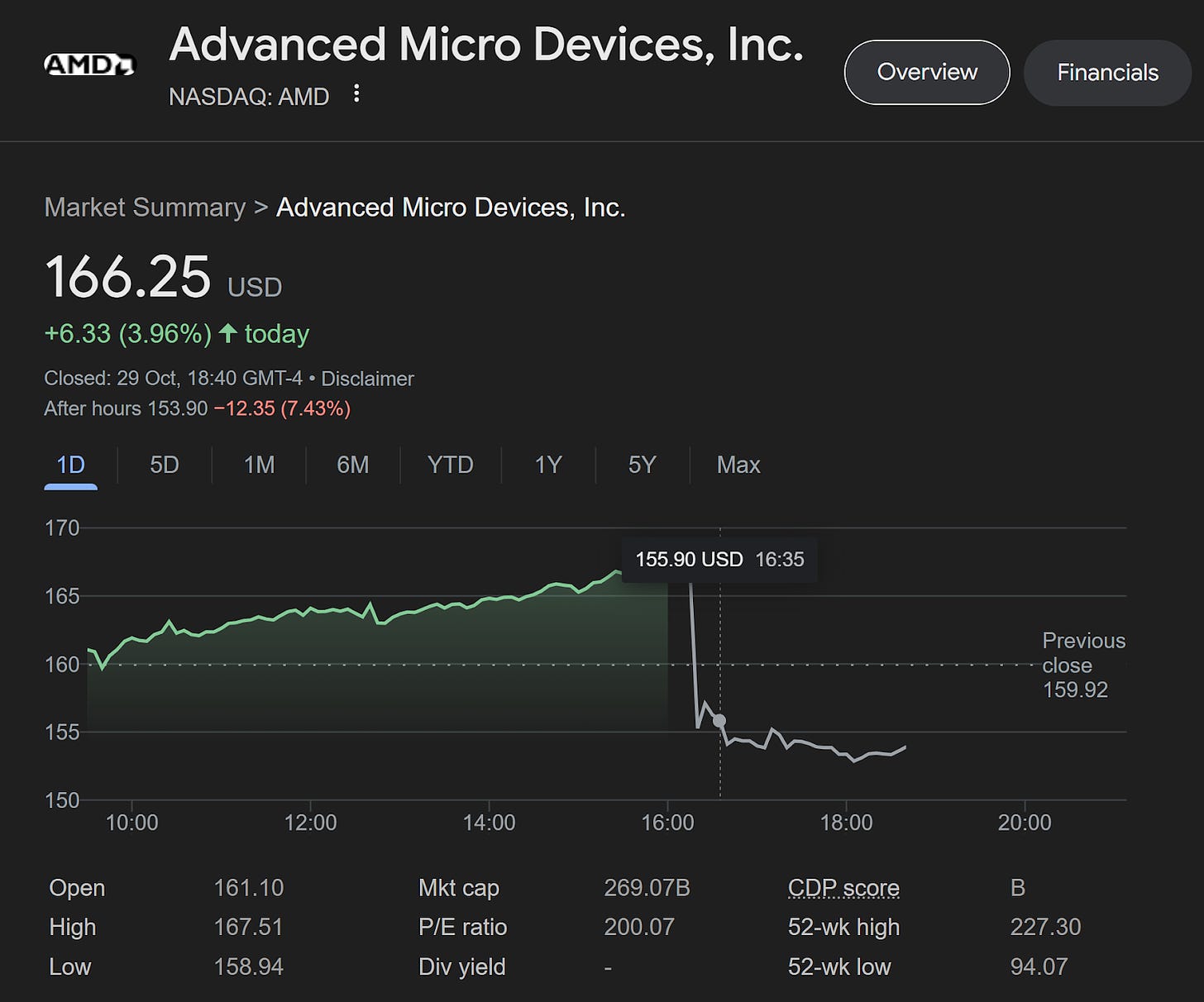
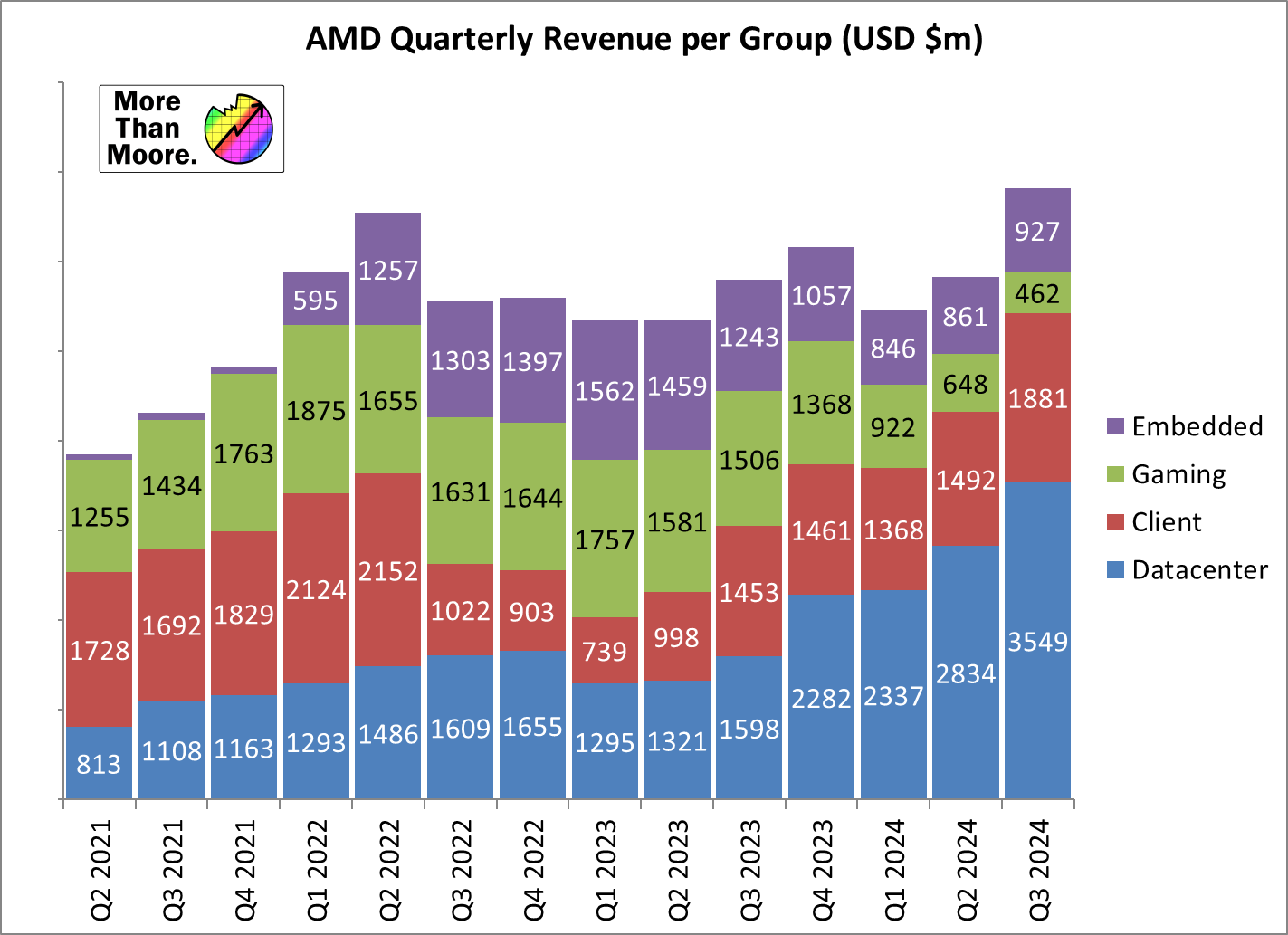
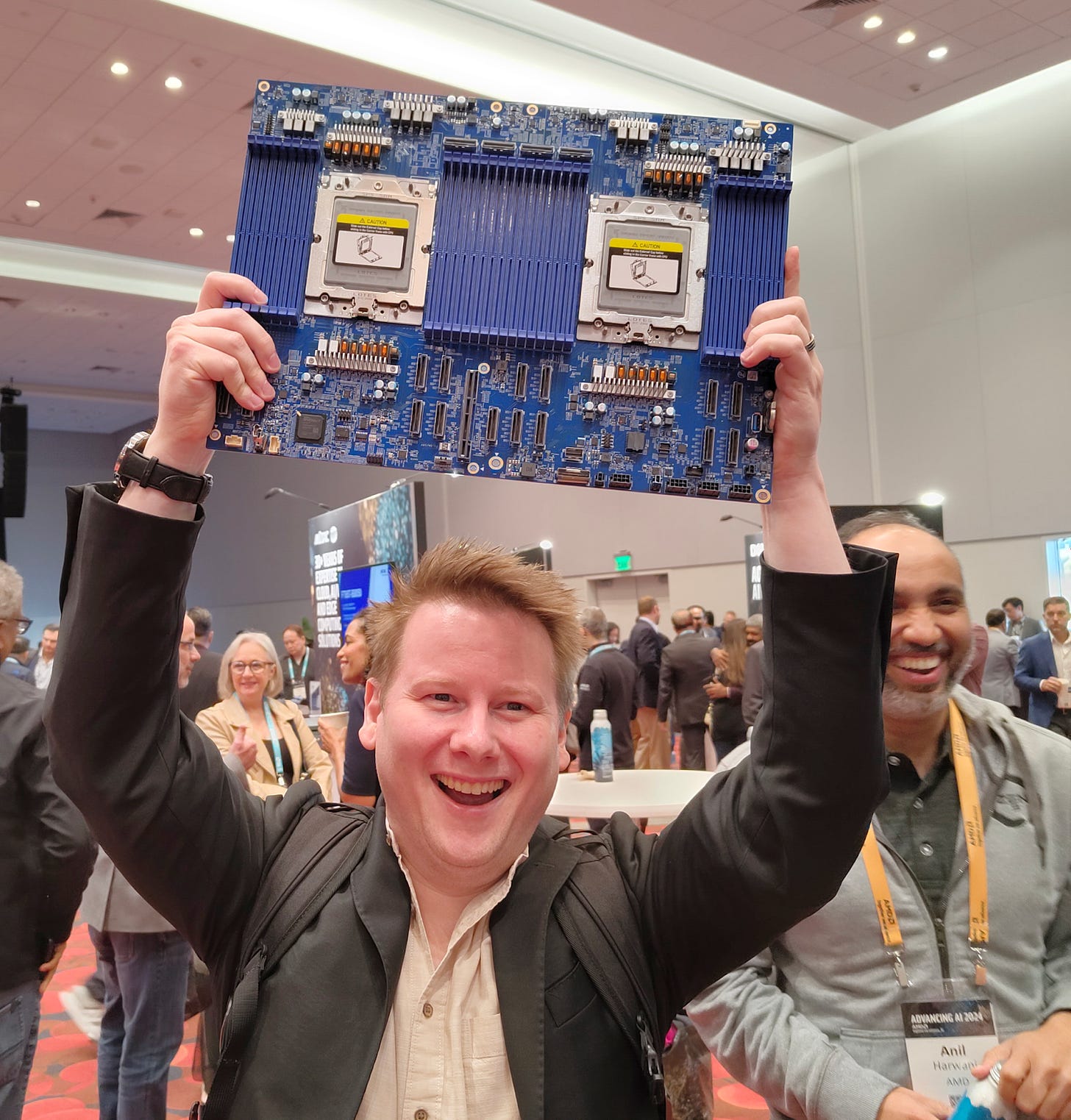
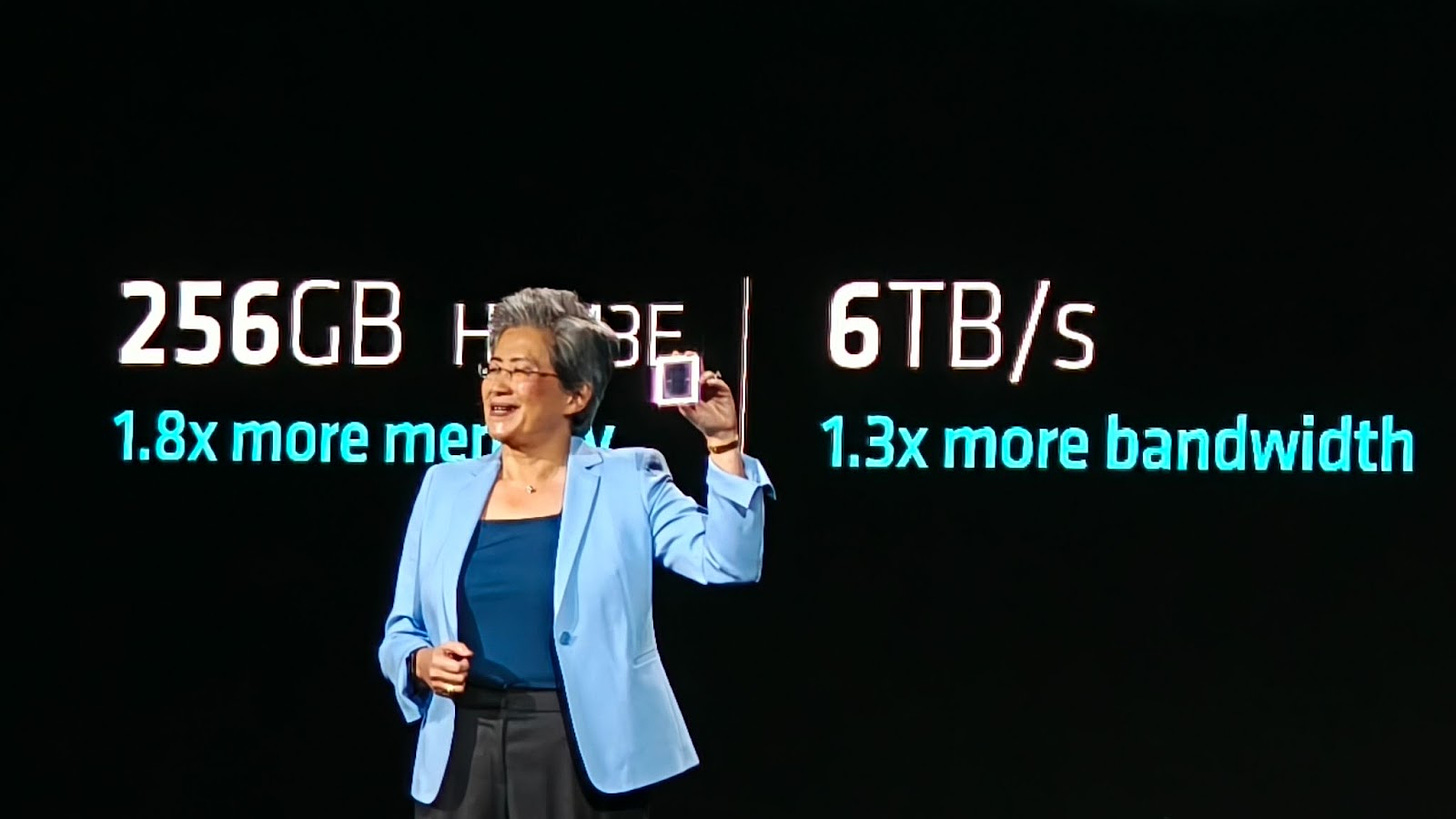
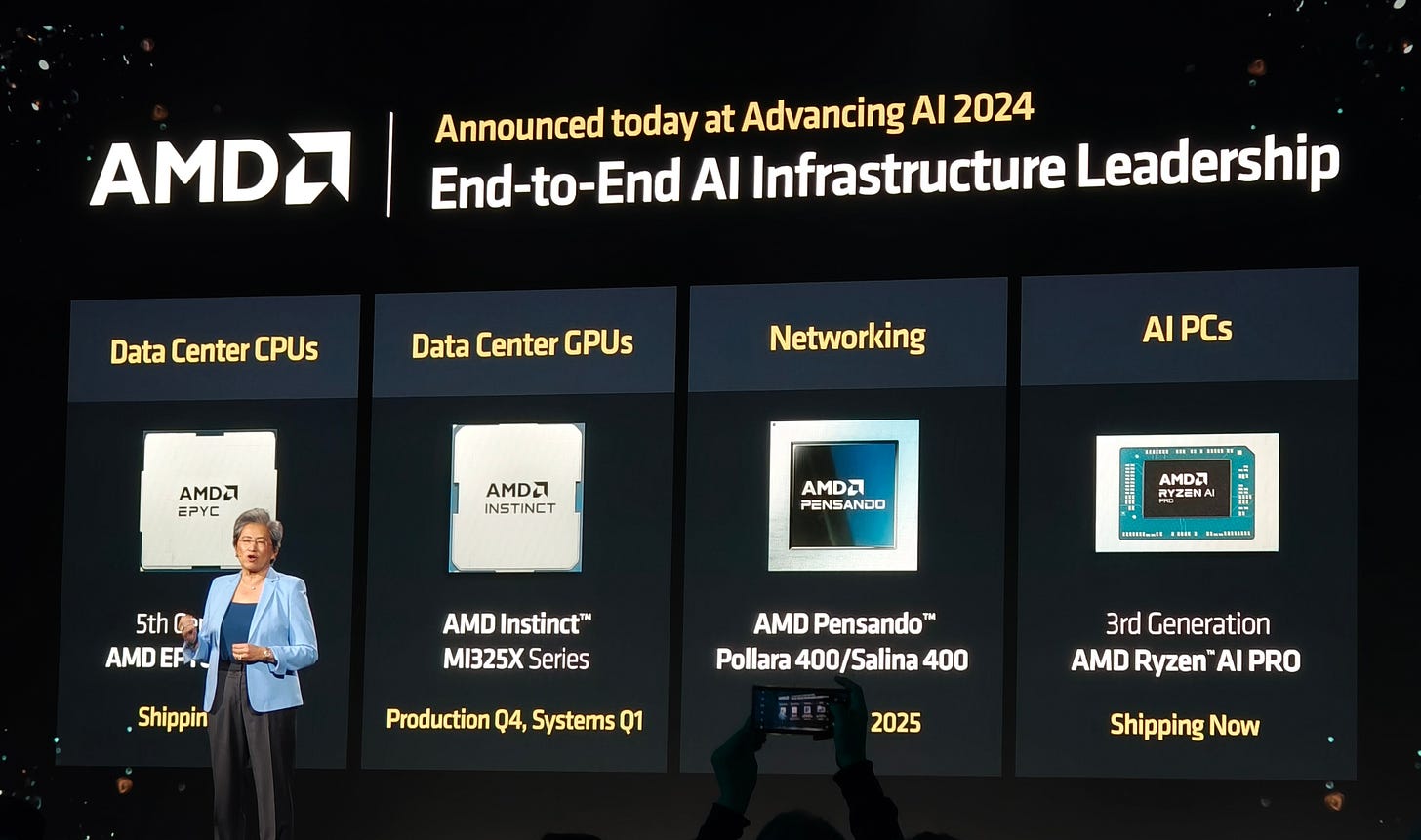
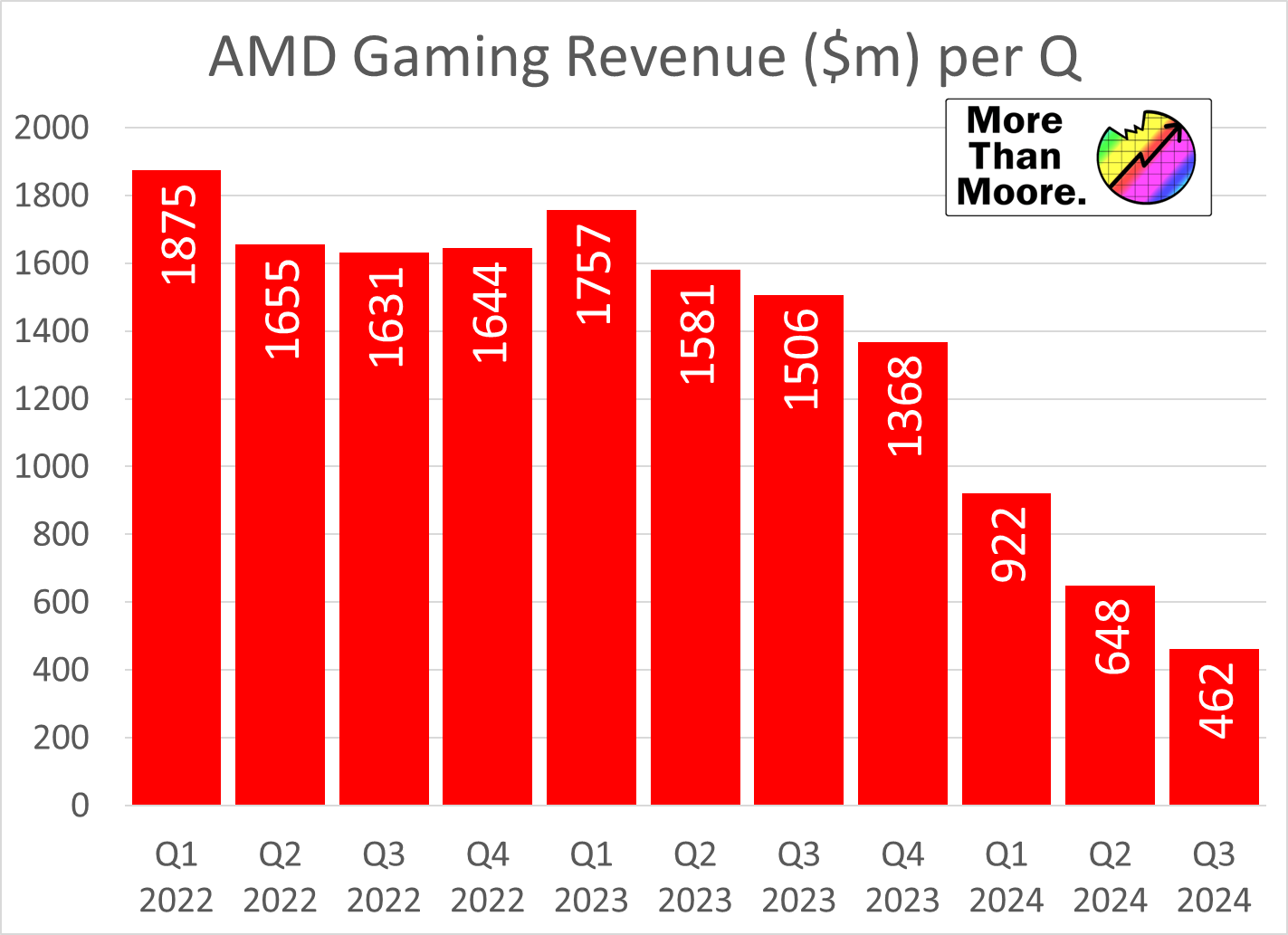
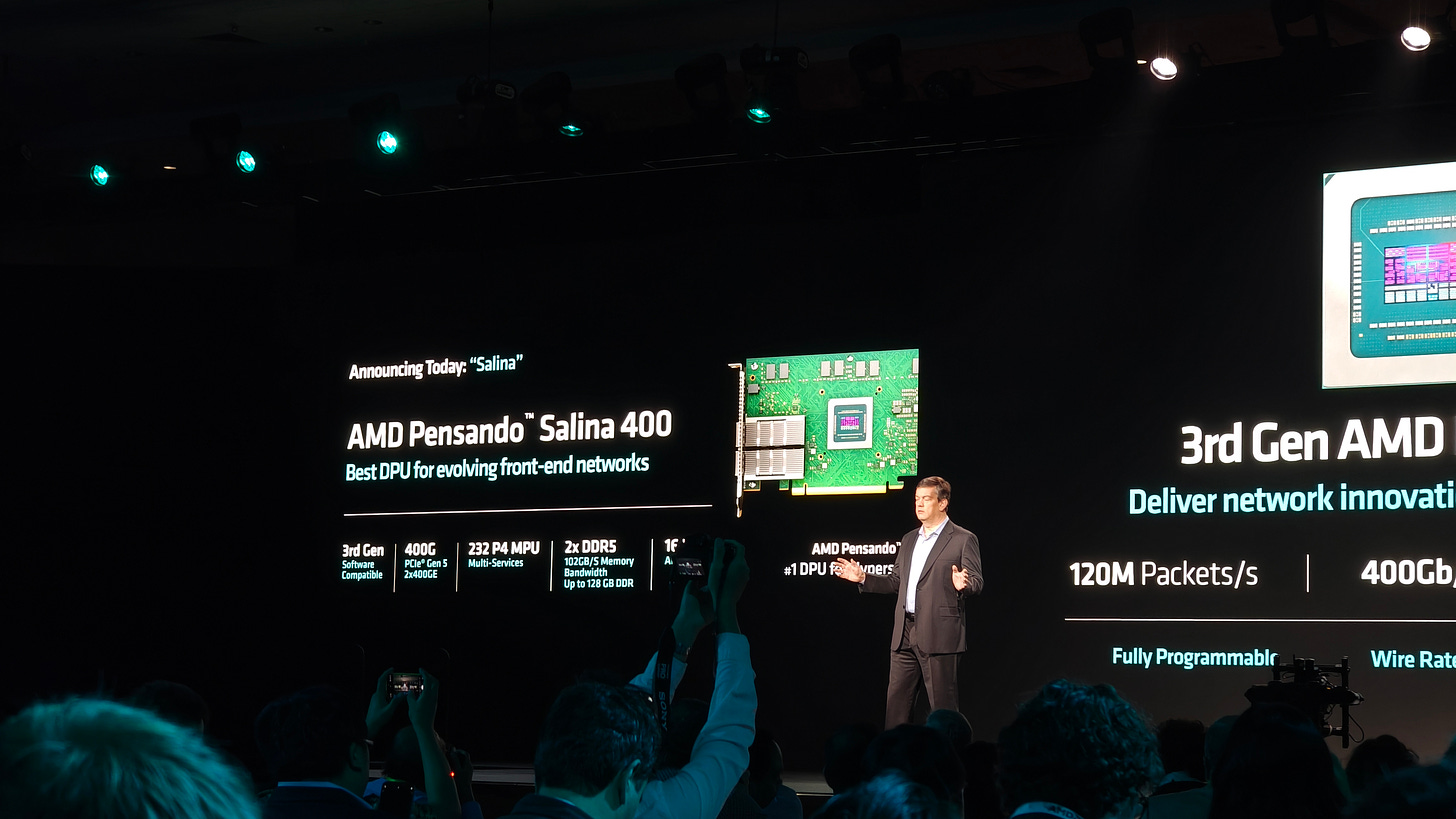
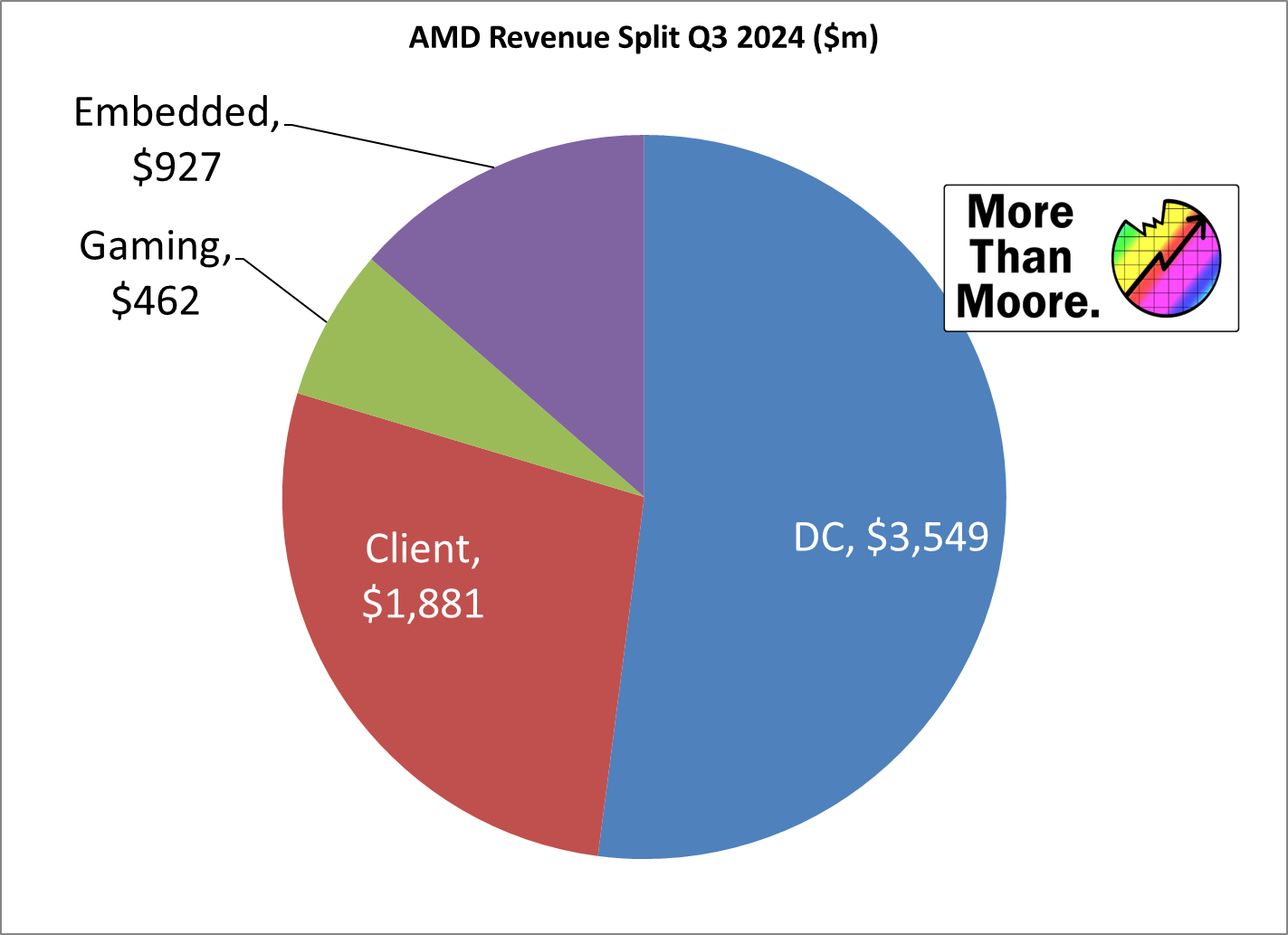

Where did you get info that Meta uses MI300X exclusively for Llama 3.1 405B? Would that mean both training and inference?
What's wrong with AMD management?
2 weeks ago everyone raised concerns about AMD focusing only on CPU and very poor presentation about GPUs and MI accelerators. If AMD only wanted to focus on CPU they should have called it a Advancing Datacenter not Advancing AI. There were no demos, turnkey solutions, end-to-end solution designs, go-to-market presentations that help gain trust in AMD capability to grow. Deliver results. Even if MI300 sales have gone from 0 to 5Billion in a year AMD fails to showcase that growth but talking too much about the CPU. Intel is a dead horse, why put energy in beating the dead horse and keep talking about CPU market.
Everyone is interested to hear AMD say out loud that they have partners, enablers, solutions, products in use and adoption is growing. But this message is hidden in or in subtext, then no one will care to unravel this mystery novel.
Earnings call was an opportunity to show strength but again AMD missed to regain the lost trust. I can understand many questions were outright stupid and unreasonable but Lisa Su kept giving irrelevant or abstract response.
This does show AMD's weakness in winning new customers. In 2024 AMD did not win a single big customer for MI300 and if demand is "good" the 2025 guidance was very bad.